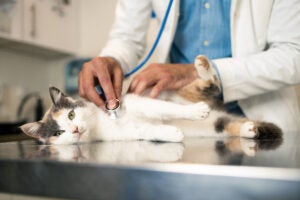What happens if you can’t afford to pay a vet bill? Follow these steps



Key takeaways
- Numerous options are available to help you pay your vet bill, including applying for a loan, emergency credit cards or payment plans.
- Low-cost clinics, veterinary colleges and financial aid can support pet owners who are facing economic hardship.
- Fundraising for a specific treatment for your pet is also another option to get support from family and friends.
- Health insurance for your pet can help ease the financial strain of an accident or illness if you purchase coverage ahead of time.
Pets can bring a lot of joy and comfort to their families. Unfortunately, like humans, animals can get sick and accidents may occur, making it necessary to get medical help for your pet. This can result in some hefty vet fees. You’re not alone in wondering what will happen if you cannot afford to pay a vet bill. In this guide, Bankrate explores what options you have if you’re struggling to pay for your pet’s care.
What to do if you can’t afford a vet bill
According to a Harris Poll survey for the Humane Society of the United States, around 20 million domestic animals in the U.S. live in poverty with their owners. Seventy percent of those dogs and cats in poverty have never seen a veterinarian. Even if you’re far from the poverty line, you may still find yourself among the 43 percent of pet owners who are unable to afford their pets’ needs at one time or another.
The good news is that there are options to help you provide for your furbaby. Here are some critical steps to take if you can’t afford a vet bill.
1. Assess the situation
Does your pet have a broken leg or just need care? Some situations are life-threatening and require urgent care, while others can wait. Many pets show unusual symptoms that worry their owners. By calling a veterinarian, you can learn which symptoms require urgent care and which ones need monitoring.
Symptoms that indicate an emergency
- Bleeding from any orifice
- Blood in urine or stool
- Broken limb
- Collapse or inability to stand
- Difficulty breathing or choking
- Inability to urinate or defecate for 24 hours
- Obvious signs of pain like vocalization or uncharacteristic aggression
- Severe blood loss from an injury
- Severe vomiting or diarrhea
If your pet is making unusual movements, limping or showing decreased appetite, lethargy or pain, monitor these symptoms and speak to a vet if they seem to worsen. Some symptoms may pass with time, while others indicate a serious issue. You know your pet best, so trust your gut if something seems unusual.
If your vet suggests that you come in for an appointment, don’t hesitate to mention your financial situation. Some may offer flexible options or alternative programs for support.
2. Explore payment plans and financing options
Discussing your financial limitations with your vet may point you toward the following options:
- Emergency credit card: Explore some of the best credit cards for emergencies. CareCredit is a great option for covering vet bills. It offers deferred interest financing for up to 24 months and low interest rates for up to 60 months.
- Personal loan: It’s possible to secure a personal loan on the same day you apply if you have a good credit score and a steady income.
- Vet payment plans: Some clinics offer installment plans that allow you to pay your bill over a few months.
3. Lean on low-cost vet clinics and financial aid
When your private veterinary clinic is not a feasible option, the following organizations can assist your pet with emergency, illness or wellness care:
- Animal shelters and rescue organizations: Many offer low-cost or free services or discount days for vaccinations or sterilizations.
- Local vet schools or teaching colleges: Some veterinary colleges offer emergency programs or clinics at reduced rates to train veterinary students. Ask whether they offer these services before any emergency situations catch you by surprise.
- Nonprofits and grant programs: Organizations such as RedRover, The Pet Fund and Banfield Foundation offer financial aid, resources and support for pet owners facing economic hardship. You’ll need to qualify for assistance, and some organizations only support specific categories of care.
4. Set up a fundraising page
Peer-to-peer fundraising or crowdfunding is a method of raising funds for a specific cause. By telling your story and sharing the link to the crowdfunding platform profile, you can let people in your social circle donate small or large amounts for your pet’s treatment. You may feel sheepish letting your friends and community know you’re in a tight spot, but you may also be blown away by their support.
Here are some popular options:
- Donately: While it does have payment tiers, Donately’s “Core” tier is ideal for individuals in need of funds. There’s no fixed cost, just a fee of 4 percent per donation.
- FreeFunder: There’s no platform fee — FreeFunder relies on donor tips. All funds raised go to your campaign.
- GoFundMe (Pet Fundraisers Category): GoFundMe doesn’t charge a platform fee, but there are payment processing fees of 2.9 percent and $0.30 for every donation.
- Waggle: This service charges zero platform fee with typical payment processing fees. Funds go directly to the vet clinic of choice.
5. Try home remedies and temporary care
Home remedies are only suitable for minor issues — always seek medical assistance for your pet in serious situations. However, you can care for your pet at home in some situations, saving on unnecessary vet bills.
- Basic home first aid: Cleaning and dressing wounds, monitoring symptoms and keeping your pet comfortable are all possible from the comfort of your home. Investing in a basic first aid kit for your cat or dog can help you treat minor injuries, allergies or a slightly upset tummy.
- TeleHealth: Hotlines or online services can provide pet health advice, though some come at a fee. MyFurries’ Ask a Vet allows you to ask a question and wait for a response in writing at no cost.
6. Sign up for pet insurance
Pet insurance is often a worthwhile cost in comparison to what your vet bill equals after a simple treatment. According to the North American Pet Health Insurance Association (NAPHIA)‘s 2023 report, here are the national averages for pet insurance:
- Accident and illness insurance for dogs: $56.30 monthly
- Accident-only insurance for dogs: $17.01 monthly
- Accident and illness insurance for cats: $31.94 monthly
- Accident-only insurance for cats: $9.68 monthly
Explore quotes from the best cheap insurance companies to find something that suits your tight budget. A little personal sacrifice may ease the stress of hefty veterinary bills down the line. The financial support for emergencies, surgeries and therapies makes pet insurance worth the cost for many.
7. Preventive care to avoid future costs
Proactive care after a major vet bill may not eliminate the costs at hand — but it can help alleviate future expenses. The following simple steps may help you avoid future vet bills:
- Brush your dog’s teeth to prevent gum disease and tooth decay. Not only are extractions and dental procedures costly, but these issues can also lead to kidney disease.
- Feed them a healthy diet. If you’re having trouble affording food for your pet, Operation Kindness and the local Society for the Prevention of Cruelty to Animals (SPCA) offer pet food pantries.
- Have your pet sterilized. Spaying and neutering your pet can prevent reproductive organ cancers and reduce their urge to wander, lowering their risk of car accidents.
- Keep up with vaccinations, flea/tick control and deworming. These treatments can prevent serious health issues down the line. Simply search “dog vaccine events near me” to find a clinic in your area hosting vaccine events.
- Make sure your pet exercises to prevent obesity, arthritis and behavior problems. Walking your dog regularly or buying interactive toys for your cat can make a big impact on their overall health.
- Save up for routine checkups. Your vet can catch issues before they become costly emergencies and illnesses.
- Sign up for pet insurance when your pet is still young. Early enrollment ensures your pet is covered with lower premiums before health issues occur.
Next steps
No one should have to choose between their pet’s life and salvaging their finances. With support from local resources, fundraising or bank assistance, you can avoid financial stress during pet emergencies. Do your research early, follow preventive care measures to keep your pet at optimal health and plan for the unexpected.
Frequently asked questions
You may also like

What alternative therapies are covered in pet insurance?



